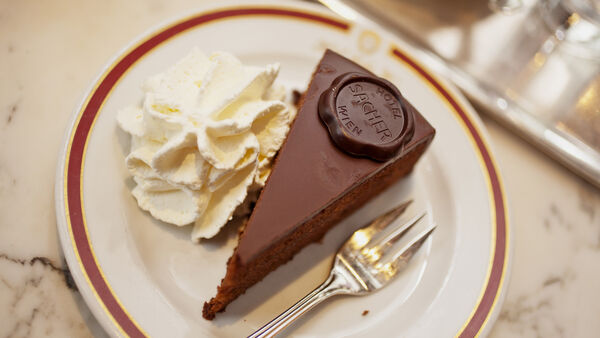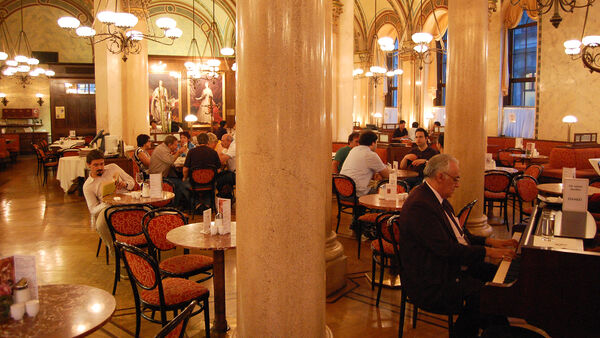Café Chitchat and Chocolate Cake: Sensing the Soul of Vienna


By Rick Steves
Munching Europe's most famous chocolate cake — the Sachertorte — in Café Sacher, across from Europe's finest opera house, I felt underdressed in well-worn khakis and Rockports.
Luckily a coffee-party of older ladies, who fit right in with the smoked mirrors and chandeliers, made me feel welcome at their table. They were buzzing with excitement about the opera they were about to see — even bursting into occasional bits of arias.
Loni, the elegant white-haired ringleader, answered my questions about Austria.
"A true Viennese is not Austrian, but a cocktail," Loni said, wiping the brown icing from her smile. "We are a mix of the old Habsburg Empire. My grandparents are Hungarian." Pointing to her friends, she said, "And Gosha's are Polish, Gabi's are Romanian, and I don't even know what hers are."
"It's a melting pot," I said.
They responded, "Yes, like America."
For 600 years Vienna was the head of the once-grand Habsburg Empire. In 1900, Vienna's 2.25 million inhabitants made it the world's fifth-largest city (after New York, London, Paris, and Berlin). Then Austria started, then lost World War I and, with it, her far-flung holdings. Today Vienna is a "head without a body" — an elegant capital ruling tiny Austria. The average Viennese mother has 1.3 children and the population is down to 1.6 million.
I asked Loni about Austria's low birthrate.
"Dogs are the preferred child," she said, startling her friends into pearl-rattling stitches.
Sharing coffee and cake with Viennese aristocracy who lived as if Vienna was an eastern Paris and as if calories didn't count, I was seeing the soul of Vienna — a city in love with life.
Vienna may have lost its political clout, but culturally and historically, this city of Freud, Brahms, a gaggle of Strausses, Maria Theresa's many children, and a dynasty of Holy Roman emperors is right up there with Paris, London, and Rome.
As far back as the 12th century, Vienna was a mecca for musicians, both secular (troubadours) and sacred. The Habsburg emperors of the 17th and 18th centuries were not only generous supporters of music but fine musicians themselves. (Maria Theresa played a mean double bass.) Composers such as Haydn, Mozart, Beethoven, Schubert, Brahms, and Mahler gravitated to this music-friendly environment. They taught each other, jammed together, and spent a lot of time in Habsburg palaces. Beethoven was a famous figure, walking — lost in musical thought — through Vienna's wooded parks.
After the defeat of Napoleon and the Congress of Vienna (in 1815, which shaped 19th-century Europe), Vienna enjoyed its violin-filled belle époque, which shaped our romantic image of the city: fine wine, cafés, waltzes, and these great chocolate cakes.
This musical tradition created the prestigious Viennese institutions that today's tourists enjoy: the opera, Boys' Choir, and great Baroque halls and churches, all busy with classical concerts.
As we split up the bill and drained the last of our coffee, the women took opera tickets out of their purses in anticipation. "Where will you be sitting?" Loni asked.
"Actually I'll be standing," I said. "I'll get a Stehplatz, a standing-room-only ticket."
The women looked at me kindly, perhaps wondering if they should have paid my bill.
"A Stehplatz is just €3.50. Then I have money left over for more Sachertorte," I said, smiling. I didn't say that, for me, a three-hour opera is a lot of opera, and a Stehplatz allows me the cheap and easy option of leaving early.
Leaving the café, we talked opera as we crossed the street. The prestigious Vienna Opera isn't backed in the pit with the famous Vienna Philharmonic Orchestra, but with its farm team: second-string strings. Still, Loni reminded me, "It's one of the world's top opera houses." Even with 300 performances a year, expensive seats are normally sold out — to well-dressed Sachertorte-eating locals.
After saying goodbye to my new friends, I headed for the standing room ticket window. Cackling as old friends do, they waltzed through the grand floor entrance and out of sight.

